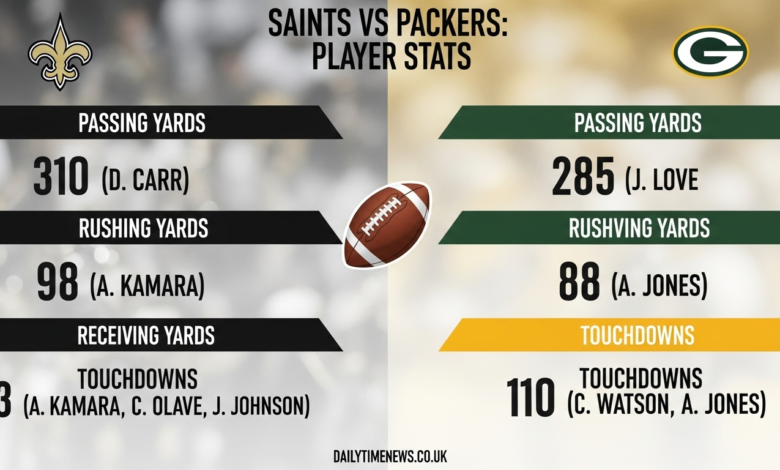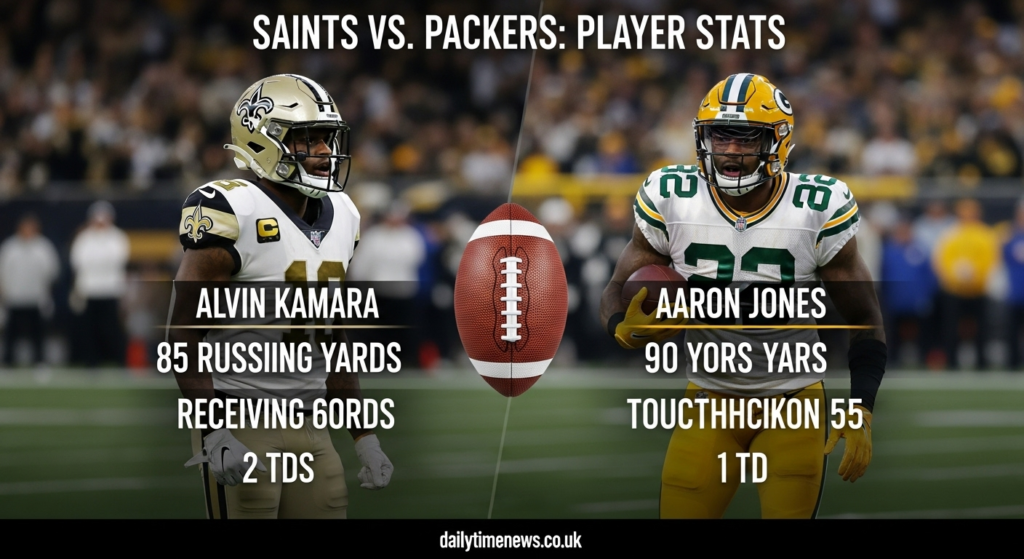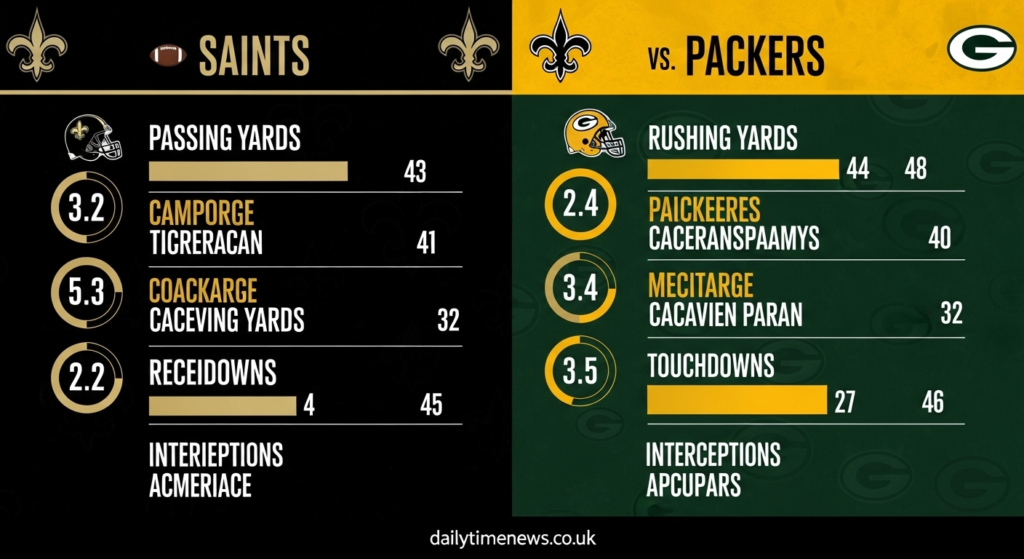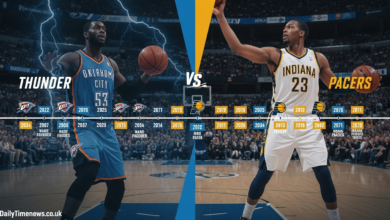Saints vs Packers Match Player Stats: Epic Breakdown

Introduction
You’ve just watched an incredible game between two storied NFL franchises, and now you’re hungry for the details. The New Orleans Saints vs Green Bay Packers match player stats tell a story that goes beyond the final score. Every completed pass, every rushing yard, and every defensive stop contributed to the drama you witnessed.
I remember watching Saints and Packers games growing up, and the statistical battles were always fascinating. These two teams have given us memorable moments throughout NFL history. Whether you’re a die-hard fan of the Black and Gold or you bleed green and gold, the numbers don’t lie.
This article breaks down the New Orleans Saints vs Green Bay Packers match player stats in detail. You’ll discover which players dominated, who struggled, and what the statistics reveal about both teams’ strengths and weaknesses. We’ll examine quarterback performances, rushing attacks, receiving corps, and defensive standouts. Let’s dive into the numbers that shaped this compelling matchup.
Quarterback Showdown: Signal Callers Under the Microscope
Passing Efficiency and Completion Rates
The quarterback battle often determines the outcome of any NFL game. In the Saints vs Packers matchup, both signal callers faced pressure to perform at elite levels. Completion percentage tells you how accurate a quarterback was throughout the game.
A completion rate above 65% generally indicates solid performance. Anything above 70% is exceptional. You want to see your quarterback making smart decisions and connecting with receivers consistently.
The yards per attempt statistic reveals how effectively a quarterback pushes the ball downfield. Higher numbers suggest explosive plays and willingness to attack vertically. Lower numbers might indicate a conservative approach or pressure from the defense.
Quarterback rating combines multiple factors into one number. It considers completions, yards, touchdowns, and interceptions. A rating above 100 is outstanding, while anything below 80 raises concerns.
Touchdown to Interception Ratio
The touchdown to interception ratio matters immensely in the Saints vs Packers match player stats. This metric shows you how well a quarterback protects the football while still being aggressive enough to score.
Elite quarterbacks typically maintain a 3:1 ratio or better. That means three touchdowns for every interception. This balance demonstrates smart decision making under pressure.
Turnovers change games instantly. A single interception can shift momentum completely. You can see how costly these mistakes become when you examine win probability charts.
Red zone efficiency also plays into touchdown production. Getting inside the 20-yard line means nothing if you can’t punch it in. The best quarterbacks convert these opportunities into six points.
Pressure and Sack Statistics
Quarterback performance under pressure separates the good from the great. The Saints vs Packers match player stats reveal how often each quarterback faced pressure and how they responded.
Time to throw averages show how quickly quarterbacks release the ball. Faster releases typically mean fewer sacks. Some quarterbacks excel at getting rid of the ball in under 2.5 seconds.
Sack numbers tell you about both offensive line performance and quarterback mobility. Mobile quarterbacks often avoid sacks through scrambling ability. Pocket passers rely more heavily on line protection.
Pressured completion percentage shows composure under duress. Some quarterbacks thrive when the pocket collapses. Others see their accuracy plummet when defenders close in.
Running Back Production and Ground Game Analysis
Rushing Yards and Yards Per Carry
The ground game establishes physical dominance and controls the clock. In the Saints vs Packers match player stats, rushing production reveals which team dictated the tempo.
Total rushing yards provide the big picture view. However, yards per carry tells you about efficiency. A running back averaging 4.5 yards per attempt is doing solid work. Anything above 5.0 per carry is excellent.
Explosive run percentage measures how often a back breaks off gains of 10 yards or more. These chunk plays keep drives alive and demoralize defenses. You want your running back creating these opportunities regularly.
Runs of 20 plus yards are true game changers. They flip field position instantly and can set up easy scoring opportunities. The best backs combine patience with explosive acceleration.

Goal Line and Short Yardage Success
Third and short situations test a team’s toughness and physicality. The Saints vs Packers match player stats show which running backs converted in crucial moments.
Goal line carries are the ultimate test for power backs. Converting from inside the five-yard line requires strength and determination. These touchdowns often prove decisive in close games.
First down conversion rate on third and short tells you about offensive line push and running back vision. Successful teams convert at least 60% of these opportunities. Anything higher gives you a significant advantage.
Broken tackle rate demonstrates a running back’s ability to create yards after contact. Some backs go down on first contact. Elite runners force multiple defenders to bring them down.
Receiving Out of the Backfield
Modern running backs must contribute in the passing game. The Saints vs Packers match player stats highlight how backs performed as receivers.
Targets and receptions show how much a quarterback trusts his running back. Check down passes to backs can save drives when downfield options disappear. Smart backs find soft spots in zone coverage.
Yards after catch for running backs often exceeds that of wide receivers. Backs catch passes in space with room to operate. A dynamic receiving back creates matchup nightmares for linebackers.
Pass blocking grade matters just as much as receiving stats. Running backs who protect their quarterback stay on the field for passing downs. This versatility makes offenses unpredictable.
Wide Receiver and Tight End Battles
Reception Leaders and Target Share
The passing game lives and dies with playmakers catching the ball. The Saints vs Packers match player stats reveal which receivers dominated targets and produced results.
Target share percentage shows how much a receiver factors into the game plan. Top receivers typically see 25% to 30% of all targets. These are the guys quarterbacks look for on crucial downs.
Receptions per target measures catch rate and reliability. Drops kill drives and confidence. You want receivers converting at least 65% of their targets into catches.
Average depth of target indicates what type of routes a receiver runs. Deep threats average 12 plus yards downfield per target. Possession receivers work shorter areas and help move chains.
Yards After Catch and Explosive Plays
Yards after catch separate good receivers from great ones. The Saints vs Packers match player stats show which pass catchers created additional yardage through effort and skill.
Making the first defender miss extends plays and gains extra yards. Receivers with elite change of direction ability consistently add 3 to 5 yards after catch. These yards accumulate throughout games.
Broken tackle rate for receivers demonstrates physicality and determination. Some receivers avoid contact. Others embrace it and fight for every inch. Physical receivers wear down defensive backs.
Plays of 20 plus yards stretch defenses and create scoring chances. Receivers who consistently generate explosive plays become offensive centerpieces. Defenses must always account for these threats.
Red Zone Targets and Touchdown Efficiency
Scoring touchdowns defines receiver value in fantasy football and real life. The Saints vs Packers match player stats highlight which pass catchers found the end zone.
Red zone target share reveals who quarterbacks trust in scoring position. Tall receivers with strong hands typically dominate inside the 20. These are contested catch specialists who win jump balls.
End zone fade routes require perfect timing and body control. Only elite receivers consistently win these matchups. You’ll see star receivers get these looks repeatedly.
Touchdown catch percentage on red zone targets shows efficiency. Some receivers see lots of looks but don’t convert. The best turn high percentages of red zone targets into six points.
Offensive Line Performance Metrics
Pass Protection Grades
The offensive line rarely gets credit but always takes blame. The Saints vs Packers match player stats include pressure rates and sacks allowed that reveal line play quality.
Quarterback hits allowed is a key metric. Even if the quarterback isn’t sacked, hits affect accuracy and decision making. Clean pockets lead to better throws and fewer turnovers.
Pressure rate allowed shows how often defenders beat blockers. Elite offensive lines keep pressure rates under 30%. Struggling lines allow pressure on 40% or more of dropbacks.
Individual matchups matter tremendously. When an offensive tackle faces an elite pass rusher, the entire game plan may adjust. You’ll see chip blocks and quicker passes to help struggling blockers.
Run Blocking Efficiency
Run blocking creates lanes for backs to exploit. The Saints vs Packers match player stats don’t always highlight line play, but it determines rushing success.
Yards before contact averages show how well linemen create holes. When backs consistently get two or three yards before contact, the line is winning. Backs hitting contact immediately indicates line struggles.
Stuff rate measures how often running plays get stopped at or behind the line of scrimmage. Low stuff rates below 15% indicate dominant line play. High rates above 25% reveal problems.
Second level yards show how often linemen reach the second level to block linebackers. This creates explosive runs and big plays. Great blocking schemes get linemen to this level consistently.
Defensive Standouts and Impact Players
Defensive Line Pressure and Sacks
Defensive linemen set the tone for the entire defense. The Saints vs Packers match player stats show which pass rushers disrupted quarterbacks and stuffed runs.
Total pressures matter more than sacks alone. A pressure forces quick throws and inaccurate passes. Elite pass rushers generate pressure on 10% or more of their rushes.
Quarterback hits demonstrate getting home even without sacks. These hits affect quarterback confidence and health. Repeated hits throughout games wear down signal callers mentally and physically.
Run stop percentage for defensive linemen shows ability against the ground game. Linemen who consistently defeat blocks and tackle ball carriers earn high grades. You need interior defenders controlling gaps.
Linebacker Coverage and Tackling
Linebackers must do everything: rush the passer, stop the run, and cover receivers. The Saints vs Packers match player stats reveal which linebackers excelled across all responsibilities.
Total tackles provide a basic measure of involvement. However, tackle quality matters more than quantity. Missed tackle percentage reveals reliability. Elite linebackers miss fewer than 10% of attempts.
Coverage stats for linebackers show versatility in the passing game. Linebackers covering running backs and tight ends must have adequate speed. Completion percentage allowed under 60% indicates strong coverage.
Tackles for loss demonstrate playmaking ability behind the line. Linebackers who regularly blow up plays in the backfield change game plans. Offenses must account for these disruptors.
Secondary Coverage Statistics
The defensive backfield determines passing game success. The Saints vs Packers match player stats include coverage numbers that show which defensive backs locked down receivers.
Targets allowed per coverage snap shows how often quarterbacks challenged a defensive back. Low target rates mean quarterbacks avoided that defender. This is the ultimate compliment for a corner.
Completion percentage allowed reveals effectiveness when targeted. Elite corners hold opponents under 50% completions. Struggling defensive backs allow 65% or higher.
Yards per target allowed combines completions and explosive plays surrendered. Giving up short completions hurts less than allowing deep balls. Corners who limit yards per target below 7.0 perform excellently.
Interceptions and pass breakups demonstrate ball skills and anticipation. Defensive backs who consistently make plays on the ball become game changers. These turnovers swing momentum dramatically.
Special Teams Impact on Game Outcome
Kicking Game Performance
Field goals and extra points seem routine until they’re missed. The Saints vs Packers match player stats include kicking results that sometimes determine winners and losers.
Field goal percentage shows accuracy under pressure. Kickers should convert everything inside 40 yards. Beyond 50 yards, success rates drop significantly. Clutch kicking in final minutes separates good from great.
Kickoff distance and touchback percentage affect field position. Touchbacks pin opponents at the 25-yard line automatically. Short kicks allow dangerous returns and better starting field position.
Punt and Return Game
Field position battles often happen through the punting game. The Saints vs Packers match player stats reveal how special teams impacted starting field position throughout the game.
Gross punting average shows pure leg strength. Net punting average accounts for returns and touchbacks. Net average matters more for overall impact. Elite punters maintain net averages above 42 yards.
Punts inside the 20-yard line demonstrate precision and touch. Punters who consistently pin opponents deep create difficult situations. These field position advantages compound throughout games.
Return averages for both punts and kickoffs can swing field position dramatically. A dangerous returner forces opponents to kick away from them. Return touchdowns obviously change games instantly.
Injury Impact and Player Availability
Key Players Missing Action
Injuries affect every NFL game’s outcome. The Saints vs Packers match player stats must be viewed through the lens of who was available and who wasn’t.
When star players miss time, backups step up or struggle trying. Depth charts reveal organizational strength. Teams with quality depth overcome injuries better than thin rosters.
In game injuries during the matchup also matter tremendously. Losing a starting tackle mid game forces offensive line shuffles. These adjustments disrupt rhythm and timing.
Injury reports before the game help you understand lineup decisions. Questionable designations mean uncertainty about availability. Game time decisions create additional drama and strategic complications.
Historical Context and Series Trends
Previous Matchups and Patterns
The Saints vs Packers rivalry includes memorable playoff games and regular season battles. Historical context helps you appreciate current matchups more fully.
Certain players seem to elevate their game against specific opponents. You’ll notice trends where particular defenders dominate certain offensive schemes. These matchup advantages repeat across multiple seasons.
Coaching matchups matter too. Some defensive coordinators consistently stifle particular offensive philosophies. Smart fans notice these patterns and anticipate strategic adjustments.
Home field advantage plays differently for various teams. The Superdome is notoriously loud and difficult for visiting teams. Lambeau Field’s cold weather and passionate fans create unique challenges.
Fantasy Football Implications
Start or Sit Decisions
Fantasy managers obsess over Saints vs Packers match player stats for good reason. These numbers directly impact weekly fantasy outcomes and playoff chances.
Target volume predictions help you identify which receivers will see opportunities. High target games translate to fantasy points even with average efficiency. You want receivers seeing eight plus targets consistently.
Touchdown upside varies by game script and opponent. Some matchups feature high scoring shootouts. Others become defensive slugfests with limited scoring chances. Game environment predictions matter enormously.
Floor and ceiling projections help with risk management. Safe floor players provide consistent points but limited upside. High ceiling players can win your week or disappoint completely.
Betting Perspectives and Statistical Trends
Over Under and Point Spread Analysis
The Saints vs Packers match player stats inform betting decisions for millions of fans. Understanding how numbers translate to betting outcomes improves your analysis.
Offensive and defensive efficiency metrics predict scoring potential. Teams averaging over 26 points per game qualify as strong offenses. Defenses allowing under 20 points weekly rank as elite units.
Pace of play affects total possessions and scoring opportunities. Fast paced offenses run more plays and create more chances to score. Slow methodical attacks drain clock and reduce possessions.
Weather conditions dramatically impact outdoor games, especially in Green Bay. Wind affects passing games significantly. Cold temperatures and snow favor running attacks and lower scoring.

Conclusion
The New Orleans Saints vs Green Bay Packers match player stats provide incredible insight into one of the NFL’s most compelling matchups. You’ve seen how quarterback efficiency, running back production, receiver performances, and defensive dominance all combine to determine outcomes. These statistics tell stories that highlight individual excellence and team success.
Understanding these numbers helps you appreciate the game on a deeper level. You can identify which matchups favor particular players. You gain insight into coaching decisions and strategic adjustments. The stats reveal truths that aren’t always obvious when watching in real time.
Whether you’re analyzing for fantasy purposes, betting angles, or pure football appreciation, the Saints vs Packers match player stats deliver valuable information. Keep tracking these numbers throughout the season. Compare performances across different opponents and conditions. The patterns you discover will enhance your football knowledge tremendously.
What player stat from this matchup surprised you most? Did the numbers align with what you observed watching the game? Share your thoughts and let’s discuss which statistics matter most when these two great franchises meet on the field.
FAQs
Who typically has better quarterback stats in Saints vs Packers games? Historically, both teams have featured elite quarterbacks who put up impressive numbers. Recent matchups depend on which roster has the stronger supporting cast and offensive line. Game environment and weather also significantly impact passing statistics in these matchups.
What are the key stats to watch in Saints vs Packers matchups? Focus on third down conversion rates, time of possession, turnover differential, and yards per play. These fundamental statistics strongly correlate with winning. Red zone efficiency and explosive play percentage also reveal which team controls the game flow.
How do Saints vs Packers player stats compare to league averages? Both franchises typically field competitive rosters that exceed league averages in multiple categories. The Packers historically have elite quarterback play while the Saints feature balanced offensive attacks. Defensive stats vary based on current roster construction and coaching schemes.
Which position group usually dominates Saints vs Packers games? Wide receivers and tight ends often shine in these matchups because both teams emphasize passing. Defensive line performance significantly impacts outcomes by pressuring quarterbacks and stopping the run. The team winning the line of scrimmage battle typically wins the game.
How reliable are player stats for predicting Saints vs Packers outcomes? Statistics provide strong indicators but cannot guarantee results. Football is unpredictable with bounces, penalties, and crucial turnovers affecting outcomes. Use stats as one tool among many when analyzing matchups. Context like injuries and weather matters just as much as historical numbers.
What Saints vs Packers player stats matter most for fantasy football? Target share, red zone touches, and snap count percentages predict fantasy production most accurately. Touchdown dependent players carry risk due to unpredictability. High volume players with consistent target numbers provide reliable fantasy floors.
How do weather conditions affect Saints vs Packers player stats? Games in Green Bay during cold weather significantly reduce passing efficiency and favor rushing attacks. Indoor games in New Orleans typically feature higher scoring and better quarterback statistics. Wind conditions at Lambeau Field can make passing nearly impossible on certain days.
Where can I find live Saints vs Packers player stats during games? NFL official website, ESPN, and Yahoo Sports provide real time statistical updates during games. Fantasy football platforms track relevant stats for managers. Sports betting apps also feature live statistics with play by play updates.
How often do Saints and Packers play each other? As teams in different conferences, the Saints and Packers meet every three to four years during regular season play. Playoff matchups occur when both teams qualify and advance through brackets. The rivalry includes several memorable postseason battles throughout NFL history.
Which Saints vs Packers game had the best individual player stats? Several matchups feature historic performances, including playoff games with multiple players exceeding 100 receiving yards. Quarterback duels between elite signal callers produced numerous games with 300 plus passing yards. Individual game records vary but both franchises have delivered memorable statistical performances in this series.
Also Read Dailytimenews.co.uk




